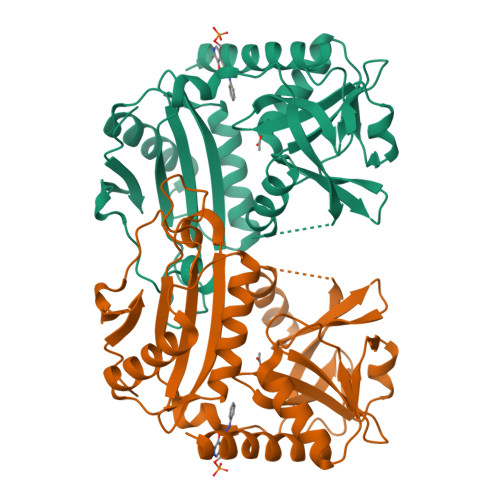Incorporation of pyridoxal-5'-phosphate into the apoenzyme: A structural study of D-amino acid transaminase from Haliscomenobacter hydrossis.
Bakunova, A.K., Matyuta, I.O., Minyaev, M.E., Boyko, K.M., Popov, V.O., Bezsudnova, E.Y.(2024) Biochim Biophys Acta Proteins Proteom 1873: 141056-141056
- PubMed: 39406293
- DOI: https://doi.org/10.1016/j.bbapap.2024.141056
- Primary Citation of Related Structures:
7P8O, 8YRT, 8YRU - PubMed Abstract:
Pyridoxal-5'-phosphate (PLP)-dependent transaminases are key enzymes of amino acid metabolism in cells and remarkable biocatalysts of stereoselective amination for process chemistry applications. As cofactor-dependent enzymes, transaminases are prone to cofactor leakage. Here we discuss the holoenzyme-apoenzyme interconversion and the kinetics of PLP incorporation into the apo form of a PLP-dependent transaminase from Haliscomenobacter hydrossis. PLP binding to the apoenzyme was slow in buffer, but was accelerated in the presence of substrates. Two crystal structures of the apoenzyme were obtained: the directly obtained apoenzyme (PDB ID: 7P8O) and the one obtained by soaking crystals of the holoenzyme in a phenylhydrazine solution (PDB ID: 8YRU). The mechanism of PLP association with the apoenzyme was proposed on the basis of structural analysis of these apo forms. Three rearrangement steps, including (I) anchoring of the PLP via the phosphate group, (II) displacement of two loops, and (III) Schiff-bonding between the PLP and the ε-amino group of the catalytic lysine residue, reconstituted the active holo form of the transaminase from H. hydrossis. The results obtained allowed us to determine in the active site a permanent part and elements that are assembled by PLP, these findings may be useful for transaminase engineering for biocatalysis.
Organizational Affiliation:
Bach Institute of Biochemistry, Research Centre of Biotechnology of the Russian Academy of Sciences, Moscow, Russia.




















